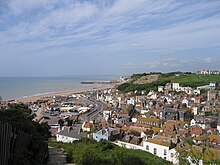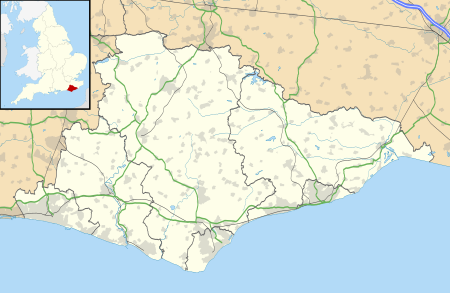
East Sussex is a ceremonial county in South East England. It is bordered by Kent to the northeast, West Sussex to the west, Surrey to the northwest, and the English Channel to the south. The largest settlement is the city of Brighton and Hove, and the county town is Lewes. The county has an area of 1,792 km2 (692 sq mi) and a population of 822,947. The latter is largely concentrated along the coast, where the largest settlements are located: Brighton and Hove (277,105), Eastbourne (99,180), and Hastings (91,490). The centre and north of the county are largely rural, and the largest settlement is Crowborough (21,990). For local government purposes, East Sussex comprises a non-metropolitan county, with five districts, and the unitary authority of Brighton and Hove. East Sussex and West Sussex historically formed a single county, Sussex.
The northeast of East Sussex is part of the Weald, a sandstone anticline that was once an extensive woodland. The highest point in this area is Crowborough Hill (242 m (794 ft)), part of the High Weald uplands. The south-west of the county is part of the South Downs, a rolling chalk escarpment that stretches west into West Sussex and Hampshire. Ditchling Beacon (248 m (814 ft)) is the highest point. Where the downs reach the sea, they form high cliffs such as the Seven Sisters, where eroded dry valleys create an undulating skyline. The county does not contain large rivers, but its largest are the Rother, which forms part of the boundary with Kent, the Cuckmere, and the Ouse, which rises in West Sussex and flows through Lewes before reaching the English Channel at Newhaven.
East Sussex is part of the historic county of Sussex, which has its roots in the ancient kingdom of the South Saxons, who established themselves there in the 5th century AD, after the departure of the Romans. Archaeological remains are plentiful, especially in the upland areas. The area's position on the coast has also meant that there were many invaders, including the Romans and later the Normans, following the defeat of the English army by William the Conqueror at the Battle of Hastings in 1066. Earlier industries included fishing, iron-making, and the wool trade, all of which have declined or been lost completely. (Full article...)
Selected article
Hastings (/ˈheɪstɪŋz/ HAY-stingz) is a seaside town and borough in East Sussex on the south coast of England, 24 mi (39 km) east of Lewes and 53 mi (85 km) south east of London. The town gives its name to the Battle of Hastings, which took place 8 mi (13 km) to the north-west at Senlac Hill in 1066. It later became one of the medieval Cinque Ports. In the 19th century, it was a popular seaside resort, as the railway allowed tourists and visitors to reach the town. Today, Hastings is a popular seaside resort and is still a fishing port with the UK's largest beach-based fishing fleet. Its estimated population was 91,100 in 2021. (Full article...)
Selected images
Selected biography
Graham McPherson (born 13 January 1961), known primarily by his stage name Suggs, is a British singer-songwriter, musician, radio personality and actor.
He came to prominence in the late 1970s as the lead singer of the ska band Madness, which released fifteen singles that entered the top 10 charts in the United Kingdom during the 1970s, 1980s and 1990s, including "My Girl", "Baggy Trousers", "Embarrassment", "It Must Be Love", "House of Fun", "Driving in My Car", "Our House", "Wings of a Dove" and "Lovestruck". Suggs began his solo career in 1995, while still a member of Madness. Since then, he has released two studio albums and two compilation albums. His solo hits include "I'm Only Sleeping", "Camden Town", "Cecilia" and "Blue Day".
Suggs has also been an actor, with roles in films, theatre and television. He is married and is the father of two children. (Full article...)
Did you know that
General images -
List articles

- List of hills of East Sussex
- List of local nature reserves in East Sussex
- List of monastic houses in East Sussex
- List of museums in East Sussex
- List of Parliamentary constituencies in East Sussex
- List of places in East Sussex
- List of settlements in East Sussex by population
- List of Sites of Special Scientific Interest in East Sussex
- List of windmills in East Sussex
Subcategories
Settlements map
Things you can do
- Add to this portal.
- Join the Sussex WikiProject
Topics
Related portals
Associated Wikimedia
The following Wikimedia Foundation sister projects provide more on this subject:
-
 Commons
Commons
Free media repository -
 Wikibooks
Wikibooks
Free textbooks and manuals -
 Wikidata
Wikidata
Free knowledge base -
 Wikinews
Wikinews
Free-content news -
 Wikiquote
Wikiquote
Collection of quotations -
 Wikisource
Wikisource
Free-content library -
 Wikiversity
Wikiversity
Free learning tools -
 Wikivoyage
Wikivoyage
Free travel guide -
 Wiktionary
Wiktionary
Dictionary and thesaurus
-

-

-

-

-
Random portal





















































































You must be logged in to post a comment.